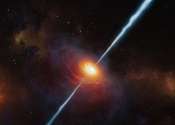HD 144941 is the most extreme helium-strong star, observations reveal
Astronomers from Austria and Northern Ireland have inspected a peculiar extreme helium supergiant star known as HD 144941. Results of the new study, published October 21 on the arXiv pre-print server, indicate that HD 144941 ...









